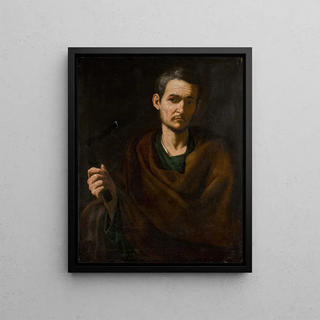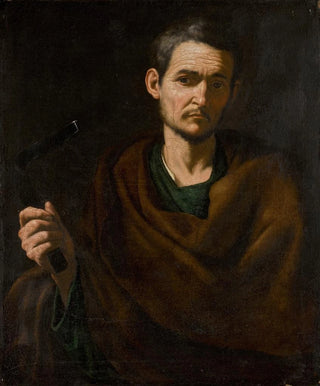Art print | Saint Philippe à mi-corps tenant un crucifix - Jusepe de Ribera


View from behind

Frame (optional)
The artwork "Saint Philippe à mi-corps tenant un crucifix" by Jusepe de Ribera is a masterpiece that embodies the spiritual depth and emotional intensity characteristic of Spanish Baroque. In this depiction, Ribera manages to capture not only the physical appearance of the saint but also his spiritual essence. Saint Philippe's penetrating gaze, combined with his hold on the crucifix, invites viewers to reflect on faith and sacrifice. This piece, both austere and majestic, demonstrates Ribera's technical mastery and his commitment to religious themes that still resonate today.
Style and uniqueness of the artwork
Ribera's style is distinguished by striking realism and bold use of light. In "Saint Philippe à mi-corps tenant un crucifix", the artist plays with shadows and highlights to create a dramatic atmosphere. The texture of the clothing, carefully rendered, and the contrast between dark tones and the brightness of the crucifix enhance the scene's intensity. The saint's face, marked by expressive features, evokes deep spirituality and palpable humanity. This approach, typical of Caravaggism, allows Ribera to transcend mere representation to offer an immersive experience that touches the soul. Every detail, from the folds of fabric to the reflections on the crucifix, is carefully thought out, demonstrating exceptional craftsmanship that makes this artwork a true celebration of faith.
The artist and his influence
Jusepe de Ribera, born in Spain but having spent much of his life in Italy, is often regarded as one of the masters of Baroque. His work is characterized by an exploration of themes of suffering and redemption, often through religious figures. Influenced by Caravaggio, Ribera developed a style that is uniquely his own, combining impeccable technique with a deep understanding of human emotions. His ability to depict pain and spirituality has left an indelible mark on European art. Later artists, both in Spain and elsewhere, were inspired by his way of playing with light and shadow.

Matte finish

View from behind

Frame (optional)
The artwork "Saint Philippe à mi-corps tenant un crucifix" by Jusepe de Ribera is a masterpiece that embodies the spiritual depth and emotional intensity characteristic of Spanish Baroque. In this depiction, Ribera manages to capture not only the physical appearance of the saint but also his spiritual essence. Saint Philippe's penetrating gaze, combined with his hold on the crucifix, invites viewers to reflect on faith and sacrifice. This piece, both austere and majestic, demonstrates Ribera's technical mastery and his commitment to religious themes that still resonate today.
Style and uniqueness of the artwork
Ribera's style is distinguished by striking realism and bold use of light. In "Saint Philippe à mi-corps tenant un crucifix", the artist plays with shadows and highlights to create a dramatic atmosphere. The texture of the clothing, carefully rendered, and the contrast between dark tones and the brightness of the crucifix enhance the scene's intensity. The saint's face, marked by expressive features, evokes deep spirituality and palpable humanity. This approach, typical of Caravaggism, allows Ribera to transcend mere representation to offer an immersive experience that touches the soul. Every detail, from the folds of fabric to the reflections on the crucifix, is carefully thought out, demonstrating exceptional craftsmanship that makes this artwork a true celebration of faith.
The artist and his influence
Jusepe de Ribera, born in Spain but having spent much of his life in Italy, is often regarded as one of the masters of Baroque. His work is characterized by an exploration of themes of suffering and redemption, often through religious figures. Influenced by Caravaggio, Ribera developed a style that is uniquely his own, combining impeccable technique with a deep understanding of human emotions. His ability to depict pain and spirituality has left an indelible mark on European art. Later artists, both in Spain and elsewhere, were inspired by his way of playing with light and shadow.






